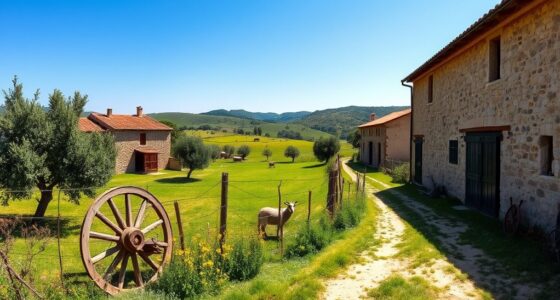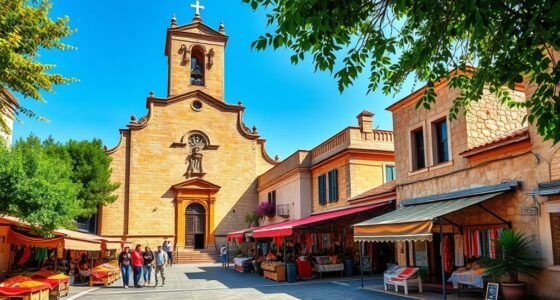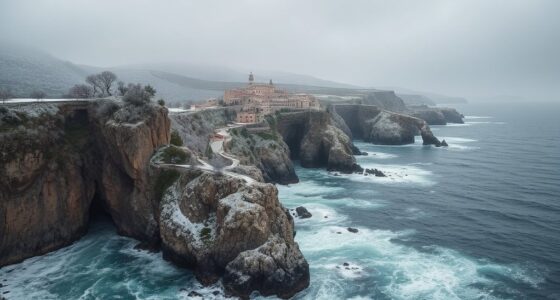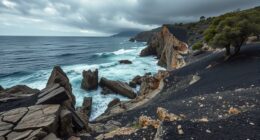In Sardinia, you can choose from eco-friendly lodging options like the Albergo Diffuso, which integrates hotels into traditional villages, or stay on organic farms that support sustainable agriculture and offer farm-to-table experiences. Family-run B&Bs provide authentic local hospitality, while eco-holiday homes showcase sustainable architecture using natural materials and energy-efficient systems. Near protected waters, marine accommodations promote marine conservation. If you keep exploring, you’ll discover how these options help preserve Sardinia’s natural beauty and culture.
Key Takeaways
- Sardinia offers diverse eco-tourism lodging types, including Albergo Diffuso, organic farmhouses, family-run B&Bs, and eco-holiday homes.
- Accommodations integrate sustainable building features like green roofs, natural materials, solar energy, and water-saving systems.
- Many lodgings promote cultural immersion through traditional architecture, local cuisine, and participatory activities.
- Marine eco-accommodations near protected zones focus on renewable energy, conservation education, and eco-friendly construction.
- Digital tools and careful territory management support sustainable tourism growth, conserving resources and preserving Sardinian landscapes.
Embracing Albergo Diffuso: Integrating Hotels Into Traditional Villages
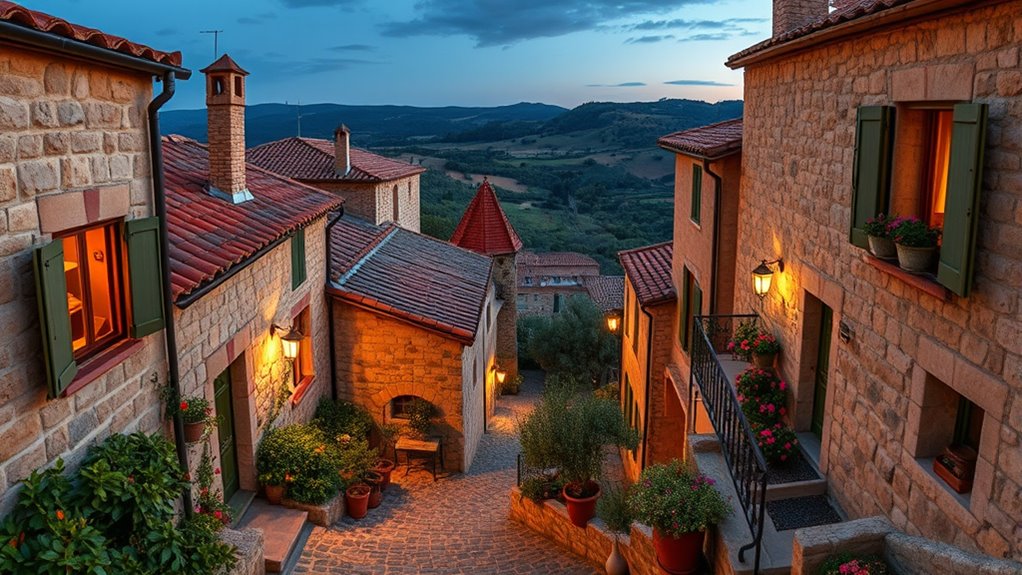
Embracing Albergo Diffuso allows travelers to immerse themselves directly in the heart of traditional Sardinian villages. Instead of staying in a single hotel building, you’ll find your accommodation scattered across restored houses integrated into the village fabric. This model revives depopulated areas by reusing existing structures, maintaining their original charm and character. You’ll experience authentic village life, engaging with locals and participating in regional customs. The buildings, often made from natural materials like stone and wood, are carefully restored to preserve their historical integrity. Despite being spread out, hotel services such as reception and housekeeping remain centralized, ensuring comfort and convenience. Staying in an Albergo Diffuso means blending modern hospitality with cultural preservation, offering a unique, genuine connection to Sardinian heritage. This approach helps sustain local communities and promotes eco‑friendly tourism, aligning with principles of sustainable eco‑tourism.
Organic Farmhouses: Staying Amidst Sardinian Agriculture and Nature
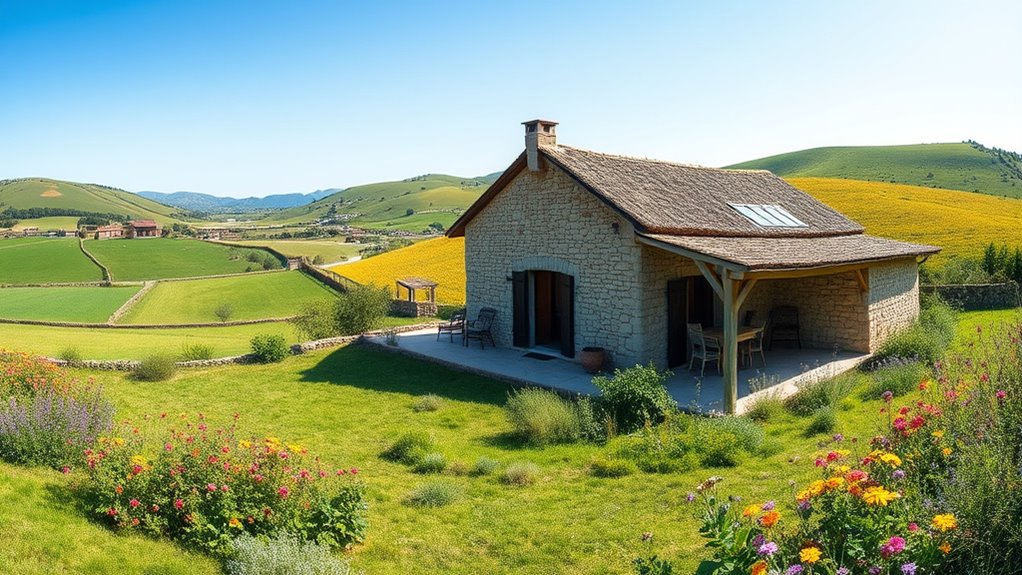
Staying in organic farmhouses in Sardinia offers a unique opportunity to immerse yourself in the island’s rich agricultural landscape and natural environment. These farmhouses adopt sustainable practices like water and energy conservation, using solar panels and rainwater collection. They emphasize waste sorting, ecological detergents, and reusing towels to reduce environmental impact. Many are located within protected parks or rural areas, supporting local biodiversity and traditional farming methods. You’ll experience firsthand the farm-to-table concept by enjoying organic, seasonal products sourced from nearby farms. Plus, you can participate in agricultural activities and learn about Sardinian customs. These accommodations foster eco-conscious travel while helping preserve Sardinia’s natural and cultural heritage. Incorporating data-driven marketing strategies can further enhance the visibility and appeal of these eco-tourism offerings to a broader audience.
Family-Run Hotels and B&Bs: Authentic Local Experiences
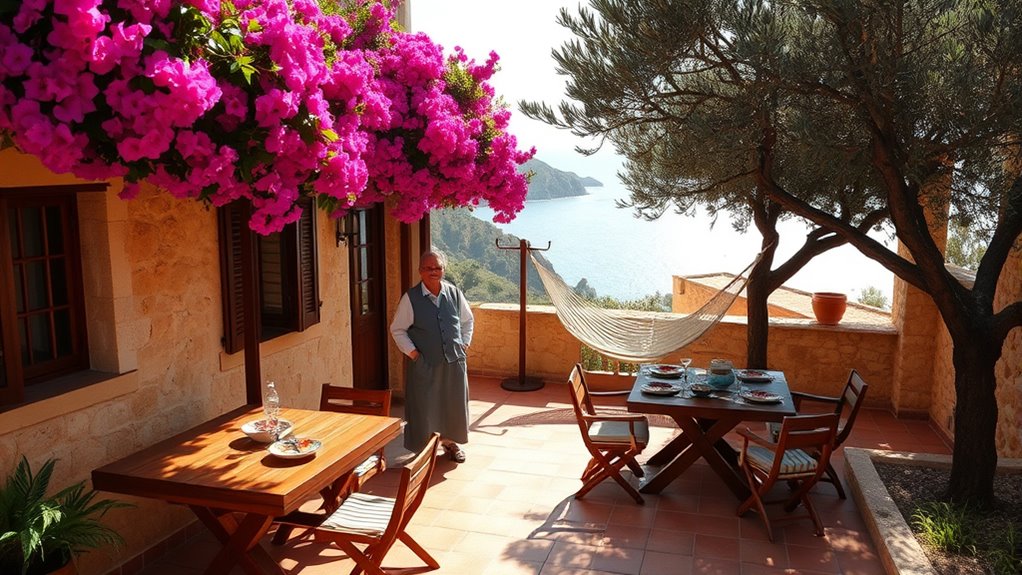
Family-run hotels and B&Bs in Sardinia offer an authentic glimpse into local life, often nestled in charming villages or scenic countryside. You’ll experience personalized service and genuine Sardinian hospitality, with hosts enthusiastic to share their culture and traditions. Many of these accommodations showcase traditional architecture and handcrafted decor, emphasizing local craftsmanship. Guests enjoy home-cooked meals featuring regional recipes and fresh, local ingredients, adding to the immersive experience. Boutique B&Bs often preserve original features like stone walls and wooden beams, creating cozy, intimate atmospheres. They may also offer activities such as cooking classes, wine tastings, or village tours, deepening your connection to Sardinian heritage. Staying here means embracing authentic experiences, away from mass tourism, in welcoming, family-owned settings.
Eco-Holiday Homes and Residences: Sustainable Architectural Designs

When choosing eco-holiday homes in Sardinia, you’ll notice designs rooted in bio-architecture principles that blend seamlessly with the landscape. These residences use sustainable materials like cork insulation and locally sourced, natural building supplies to minimize environmental impact. Plus, smart energy and water-efficient systems make certain you enjoy comfort without compromising the island’s delicate ecosystems. Environmentally friendly building practices are emphasized, ensuring that each structure supports conservation efforts and promotes a harmonious relationship with nature. Incorporating attention to detail in design enhances the functionality and aesthetic appeal of these eco-residences, further aligning with sustainable principles.
Bio-Architecture Principles
Bio-architecture principles transform eco-holiday homes and residences into sustainable, harmonious structures by emulating nature’s forms and processes. You’ll see designs inspired by natural patterns that optimize both function and beauty, creating a seamless connection with the environment. Incorporating natural elements indoors—like plants, daylight, and airflow—boosts occupant wellbeing and reinforces your bond with nature. Passive strategies, such as building orientation for solar gain, large windows, and green roofs, naturally regulate temperature and reduce energy needs. Renewable technologies like solar panels and rainwater harvesting further minimize environmental impact. These principles foster resource efficiency, utilizing local, eco-friendly materials and biomimicry-inspired techniques. Research and collaboration with biologists help architects develop innovative solutions that are both sustainable and deeply integrated with natural ecosystems. An understanding of relationships and environmental psychology can also enhance the design process by promoting harmony between inhabitants and their surroundings. Ultimately, bio-architecture creates spaces that are not only sustainable but also uplifting, supporting your health while respecting Sardinia’s natural landscape.
Eco-Friendly Construction Materials
Sustainable architectural designs in Sardinia prioritize the use of eco-friendly construction materials that blend seamlessly with the island’s natural environment. You’ll find locally sourced timber and wood from Sardinian forests, reducing transportation emissions and supporting local economies. Using renewable cork harvested from native cork oak trees offers natural insulation, moisture resistance, and durability, all without harming the trees. Clay, terracotta, and earth-based materials provide excellent thermal mass, regulate humidity naturally, and maintain indoor air quality by avoiding synthetic chemicals. Sheep wool insulation offers effective thermal and acoustic properties with minimal processing, enhancing comfort and sustainability. Additionally, green roofs with native stone and vegetation improve insulation, promote biodiversity, and integrate buildings into the landscape. These materials ensure your eco-holiday residence is both environmentally responsible and harmoniously connected to Sardinia’s natural beauty. The use of eco-sustainable materials like cork and sheep wool supports resource conservation and circular economy principles.] Incorporating innovative construction techniques can further reduce environmental impact and increase energy efficiency in your sustainable retreat.
Energy and Water Efficiency
Eco-holiday homes in Sardinia incorporate innovative energy and water efficiency measures that minimize environmental impact and reduce operational costs. You’ll find solar panels powering these residences, cutting reliance on fossil fuels, while low-energy bulbs and Class A appliances lower electricity use. Electric vehicles and golf carts promote clean transportation on-site. Smart climate control systems optimize heating and cooling, conserving energy, and architecture designed for natural ventilation and daylight reduces artificial lighting needs. Water-saving fixtures, rainwater harvesting, and drought-resistant landscaping conserve resources. Reusing linens, recycling waste, and using eco-friendly detergents further minimize water and chemical impact. These homes often feature green roofs, thermal insulation, and strategic design that leverages local climate conditions. Many of these residences also incorporate renewable energy sources such as wind turbines and geothermal systems to further enhance sustainability. All these measures support sustainable living while preserving Sardinia’s natural beauty.
Marine Area Lodgings: Eco-Conscious Accommodations Near Protected Waters
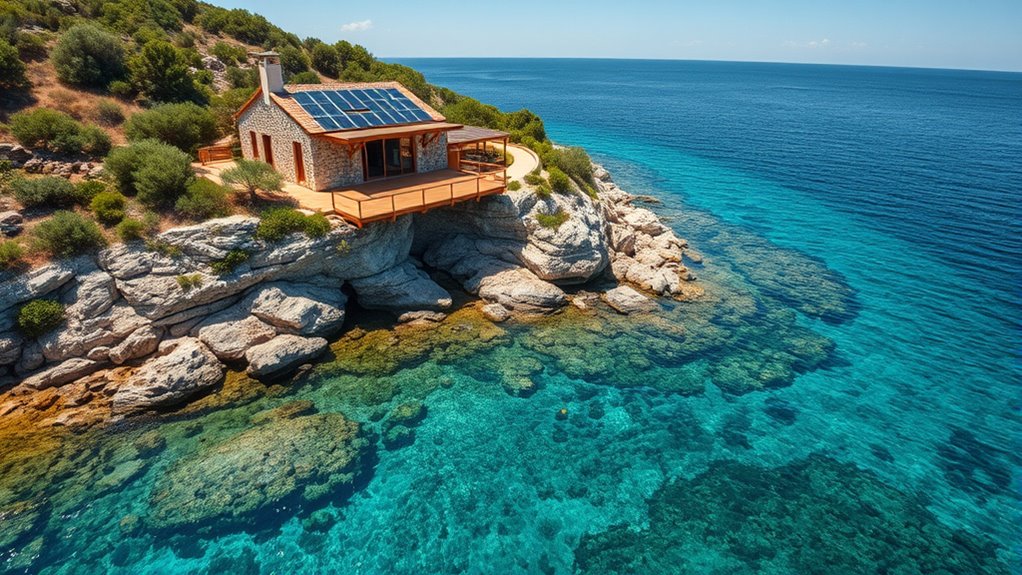
Living close to Sardinia’s protected marine areas offers you the chance to stay in accommodations that prioritize environmental responsibility. These lodgings actively minimize their impact through sustainable practices, such as:
- Using renewable energy sources like solar panels and rainwater collection systems
- Implementing waste sorting, recycling, and eco-friendly cleaning products
- Sourcing local, seasonal Mediterranean products for on-site restaurants
- Promoting eco-activities like kayaking, bird watching, and exploring marine ecosystems
Many resorts near marine protected zones, like Capo Carbonara, incorporate eco-management and educational programs, encouraging conservation awareness. These accommodations blend natural materials with low-impact construction, providing comfort without harming the environment. Staying here helps you connect authentically with Sardinia’s pristine waters while supporting sustainable tourism.
Balancing Capacity and Infrastructure for Eco-Tourism Growth
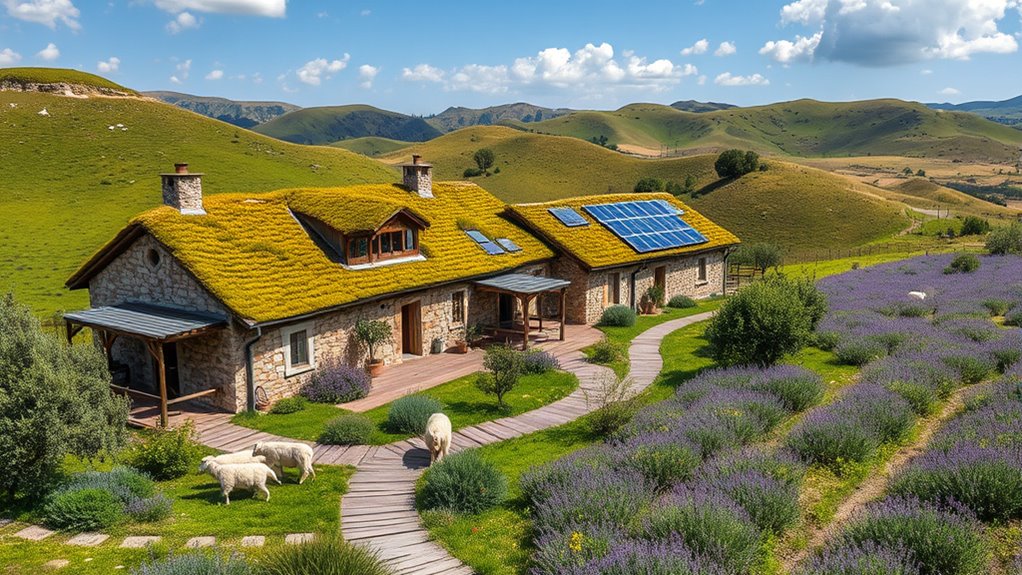
Balancing tourism growth with environmental protection requires careful management of Sardinia’s infrastructure capacity. With over 5,600 accommodations and roughly 217,000 beds, there’s significant potential for expansion. However, utilization was low in 2020, mostly around 10%, showing room for growth without immediate strain. Strategic plans focus on managing territory capacity to preserve landscapes and prevent resource overuse. Water consumption, like in Castelsardo, accounts for nearly 9% of regional supplies, demanding sustainable infrastructure. Waste production fluctuates, and unregistered tourists complicate capacity assessments, emphasizing the need for effective waste management systems. Digital tools and participatory planning help optimize resource use and distribute tourist flows. Tourism planning efforts are increasingly focusing on sustainable infrastructure development to support eco-tourism growth while safeguarding Sardinia’s environmental integrity. To effectively manage resources, incorporating environmental impact assessments into planning processes is essential.
Environmental and Economic Benefits of Sustainable Lodging Options
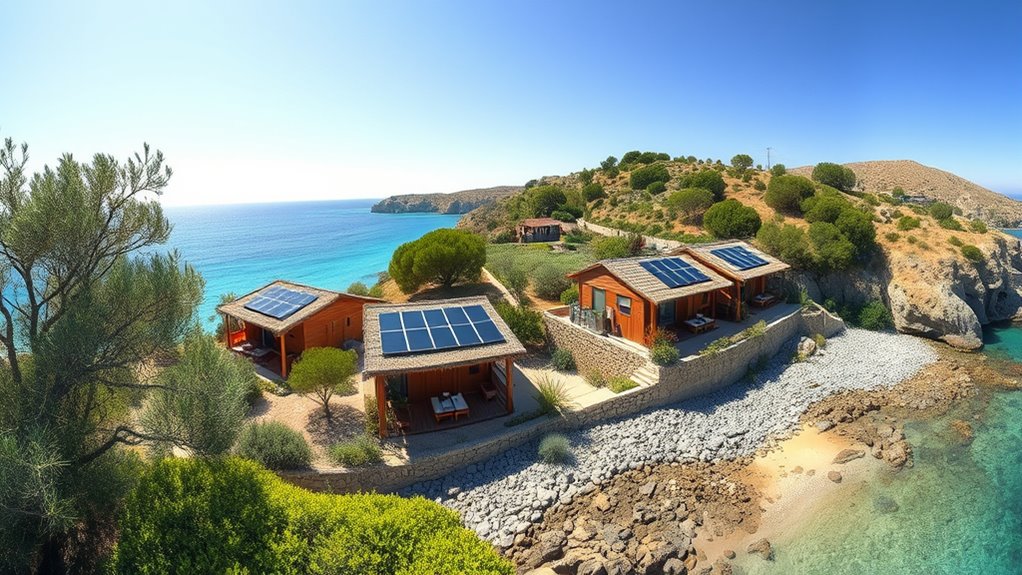
Sustainable lodging options in Sardinia deliver significant environmental and economic advantages by integrating eco-friendly practices into tourism infrastructure. These accommodations reduce energy use through solar panels, energy-efficient appliances, and LED lighting, cutting greenhouse emissions. They also conserve water with rainwater collection systems, water-saving fixtures, and reuse programs. Additionally, eco-lodges support local economies by prioritizing organic, regional foods and sourcing from nearby producers. They foster cultural preservation by engaging with local traditions and empowering small businesses. Here are four key benefits: Lower environmental impact through renewable energy and waste reduction, which further minimizes pollution and resource depletion, Preservation of natural water resources and ecosystems, which is vital for maintaining biodiversity, Support for local communities and sustainable agriculture, and Attraction of eco-conscious travelers, boosting regional tourism and employment. These practices promote a greener, more resilient Sardinia.
Frequently Asked Questions
How Do Eco-Lodgings in Sardinia Ensure Water Conservation?
You can see eco-lodgings in Sardinia conserve water through innovative practices. They recycle greywater for irrigation, maintain chlorine-free pools, and use biodegradable systems for landscape watering. Rainwater harvesting supplies gardens, while efficient fixtures cut water use by up to 50%. Native plants reduce irrigation needs, and automated systems optimize water distribution. By combining these methods, you’re helping preserve Sardinia’s precious water resources while enjoying eco-friendly accommodations.
Are There Specific Certifications for Sustainable Accommodations in Sardinia?
You’ll find that Sardinia offers specific certifications for sustainable accommodations, like the Global Sustainable Tourism Council (GSTC) certification, which guarantees high social and environmental standards. Many eco-lodges also pursue Ecolabels, COSMOS, and other eco-certifications focused on organic sourcing, local materials, and minimal environmental impact. These certifications help you identify accommodations committed to sustainability, supporting local communities, reducing carbon footprints, and promoting eco-friendly practices throughout your stay.
What Transportation Options Connect Eco-Lodgings to Main Tourist Sites?
Connecting eco-lodgings to tourist sites is like a web of options you can weave. You can hop on public buses operated by ARST, which link major towns to beach areas and small communities. Trains from Trenitalia and scenic tourist rail lines offer budget-friendly travel through rural landscapes. For more flexibility, renting a car gives you direct access to remote spots. Ferries, taxis, and shuttles complete the network, ensuring you reach your eco-friendly destination smoothly.
How Do Local Communities Benefit From Eco-Tourism Lodging Development?
You benefit from eco-tourism lodging development as it creates jobs in hospitality, guiding, and conservation, boosting local income. It supports fisheries and agriculture, helping diversify your economy and reduce reliance on mass tourism. Eco-tourism also promotes cultural preservation and community involvement, strengthening regional identity. Plus, it helps protect natural habitats, ensuring sustainable growth and improving your quality of life while fostering long-term community resilience.
Can Eco-Friendly Accommodations Cater to Travelers With Disabilities?
You’ll find eco-friendly accommodations increasingly include accessible features like barrier-free bathrooms and ramps, ensuring travelers with disabilities can enjoy the environment comfortably. Many locations prioritize inclusive design, blending sustainability with accessibility. These accommodations not only support eco-conscious practices but also promote equal tourism opportunities. By choosing these options, you get to experience Sardinia’s natural beauty while feeling welcomed and accommodated, making your eco-tourism journey both responsible and inclusive.
Conclusion
By choosing eco-tourism lodging options in Sardinia, you help preserve the island’s natural beauty and support local communities. Did you know that sustainable accommodations can reduce water use by up to 30%? Your stay in eco-friendly hotels, farmhouses, or villages not only offers authentic experiences but also contributes to environmental conservation and economic growth. Together, you can enjoy Sardinia’s rich culture while making a positive impact for future visitors.


